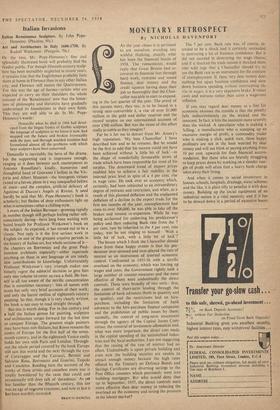Italian Invasions
Italian Renaissance Sculpture. By John Pope Hennessy. (Phaidon, 90s.) Art and Architecture in Italy 1600-1750. By Rudolf Wittkower. (Penguin, 70s.) OF the two, Mr. Pope-Hennessy's fine and • splendidly illustrated book will probably find the eeadier. public. For though fifteenth-century sculp- ture has been incredibly neglected in recent years, it remains true that the Englishman probably feels more at home in Florence than in any other Italian city, and Florence still means the Quattrocento. For this was the age of heroes—artists who are expected to carry on their shoulders the 'whole concept of the 'Renaissance' now that the histor- ians of philosophy and literature have gradually undermined its foundations in their own fields. This they are well able to do. In Mr. Pope- Hennessy's words : . . Donatello when he died in 1466 had devel- oped from the lingua franca of Gothic sculpture the language of sculpture as we know it now, had mapped out the future and broken irrevocably with the past, and through unaided intuition had formulated almost all the .problems with which later sculptors have been concerned.
Donatello is inevitably the hero of the drama, but the supporting cast is impressive enough, ranging as it does between such masterpieces as Antonio Rossellino's kindly, humorous and thoughtful head of Giovanni Chellini in the Vic- toria and. Albert Museum—the bourgeois virtues raised to a heroic.plane in a way unequalled before or since—and the complex, artificial delicacy of Agostino di Duccio's Angels at Rimini. It need hardly be said that Mr. Pope-Hennessy's book is scholarly; but flashes of deep enthusiasm light up what is sometimes rather a chilling style.
Lovers of the Italian Baroque—growing rapidly in number though still perhaps feeling rather self- consciously daring—have long been waiting with bated breath for Professor Wittkower's book on the subject. As expected, it has turned out to be a classic. Not only is it the first serious work in English on one of the greatest creative periods in the history of Italian art, but whole sections of it— the chapters on Borromini and the great Pied- montese architects especially—either supersede anything on them in any language or are totally new contributions to knowledge. Unfortunately Professor Wittkower's very triumph makes one bitterly regret the editorial decision to give him only one volume to cover so vast a field. He him- self is all too aware of the terrific concentration that is sometimes necessary : lists of names with acute but only very brief accounts of their work; and only the barest outline of eighteenth-century painting. So that, though it is very clearly written, the book is not easy to read straight through.
But this is worth doing. For in this century and a half the Italian genius for painting, sculpture and architecture surges forward for the last time to conquer Europe. The greatest single painters may have been non-Italians, but Rome remains the centre of Europe for the first half of the seven- teenth century, and in the eighteenth Venice easily holds her own with Paris and London. Through- out the whole period covered by the book Europe still saw this world and the next through the eyes of Caravaggio and the Carracci, Bernini and Salvator Rosa, Borromini and Guarini, Tiepolo and Canaletto. Reading here the account of the works of these artists and countless more one is totally bewildered by the taste that could and occasionally still does talk of 'decadence.' As yet less familiar than the fifteenth century, this too was an age of supreme creations, and now at last it has been worthily recorded.
FRANCIS HASKELL


























 Previous page
Previous page